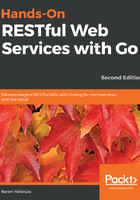
Fundamentals of gorilla/mux
The gorilla/mux package primarily helps to create routers, similar to httprouter. The difference between both is the attachment of a handler function to a given URL. If we observe, the gorilla/mux way of attaching a handler is similar to that of basic ServeMux. Unlike httprouter, gorilla/mux wraps all the information of an HTTP request into a single request object.
The three important tools provided in the gorilla/mux API are:
- The mux.NewRouter method
- The *http.Request object
- The *http.ResponseWriter object
The NewRouter method creates a new router object. That object basically maps a route to a function handler. gorilla/mux passes a modified *http.Request and *http.ResponseWriter object to the function handler. These special objects have lots of additional information about headers, path parameters, request body, and query parameters. Let us explain how to define and use different routers in gorilla/mux with two common types:
- Path-based matching
- Query-based matching